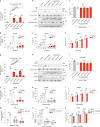Dampened NLRP3-mediated inflammation in bats and implications for a special viral reservoir host
- PMID: 30804542
- PMCID: PMC7096966
- DOI: 10.1038/s41564-019-0371-3
Dampened NLRP3-mediated inflammation in bats and implications for a special viral reservoir host
Abstract
Bats are special in their ability to host emerging viruses. As the only flying mammal, bats endure high metabolic rates yet exhibit elongated lifespans. It is currently unclear whether these unique features are interlinked. The important inflammasome sensor, NLR family pyrin domain containing 3 (NLRP3), has been linked to both viral-induced and age-related inflammation. Here, we report significantly dampened activation of the NLRP3 inflammasome in bat primary immune cells compared to human or mouse counterparts. Lower induction of apoptosis-associated speck-like protein containing a CARD (ASC) speck formation and secretion of interleukin-1β in response to both 'sterile' stimuli and infection with multiple zoonotic viruses including influenza A virus (-single-stranded (ss) RNA), Melaka virus (PRV3M, double-stranded RNA) and Middle East respiratory syndrome coronavirus (+ssRNA) was observed. Importantly, this reduction of inflammation had no impact on the overall viral loads. We identified dampened transcriptional priming, a novel splice variant and an altered leucine-rich repeat domain of bat NLRP3 as the cause. Our results elucidate an important mechanism through which bats dampen inflammation with implications for longevity and unique viral reservoir status.
Conflict of interest statement
The authors declare no competing interests.
Figures





Comment in
-
"On the bat's back I do fly".Nat Rev Microbiol. 2019 May;17(5):265. doi: 10.1038/s41579-019-0177-6. Nat Rev Microbiol. 2019. PMID: 30842614 Free PMC article.
-
Bat tolerance to viral infections.Nat Microbiol. 2019 May;4(5):728-729. doi: 10.1038/s41564-019-0430-9. Nat Microbiol. 2019. PMID: 31015739 Free PMC article.
Similar articles
-
Activation of the NLRP3 inflammasome by IAV virulence protein PB1-F2 contributes to severe pathophysiology and disease.PLoS Pathog. 2013;9(5):e1003392. doi: 10.1371/journal.ppat.1003392. Epub 2013 May 30. PLoS Pathog. 2013. PMID: 23737748 Free PMC article.
-
NS1 Protein of 2009 Pandemic Influenza A Virus Inhibits Porcine NLRP3 Inflammasome-Mediated Interleukin-1 Beta Production by Suppressing ASC Ubiquitination.J Virol. 2018 Mar 28;92(8):e00022-18. doi: 10.1128/JVI.00022-18. Print 2018 Apr 15. J Virol. 2018. PMID: 29386291 Free PMC article.
-
PB1-F2 protein of highly pathogenic influenza A (H7N9) virus selectively suppresses RNA-induced NLRP3 inflammasome activation through inhibition of MAVS-NLRP3 interaction.J Leukoc Biol. 2020 Nov;108(5):1655-1663. doi: 10.1002/JLB.4AB0420-694R. Epub 2020 May 9. J Leukoc Biol. 2020. PMID: 32386456
-
The role of the NLRP3 inflammasome in regulation of antiviral responses to influenza A virus infection.Antiviral Res. 2017 Dec;148:32-42. doi: 10.1016/j.antiviral.2017.10.020. Epub 2017 Oct 31. Antiviral Res. 2017. PMID: 29097227 Review.
-
Mechanism and Regulation of NLRP3 Inflammasome Activation.Trends Biochem Sci. 2016 Dec;41(12):1012-1021. doi: 10.1016/j.tibs.2016.09.002. Epub 2016 Sep 23. Trends Biochem Sci. 2016. PMID: 27669650 Free PMC article. Review.
Cited by
-
Lipopolysaccharide detection by the innate immune system may be an uncommon defence strategy used in nature.Open Biol. 2022 Oct;12(10):220146. doi: 10.1098/rsob.220146. Epub 2022 Oct 5. Open Biol. 2022. PMID: 36196535 Free PMC article. Review.
-
Precision Medicine in COVID-19: IL-1β a Potential Target.JACC Basic Transl Sci. 2020 Apr 18;5(5):543-544. doi: 10.1016/j.jacbts.2020.04.006. eCollection 2020 May. JACC Basic Transl Sci. 2020. PMID: 32313848 Free PMC article. No abstract available.
-
Inflammasomes and Pyroptosis as Therapeutic Targets for COVID-19.J Immunol. 2020 Jul 15;205(2):307-312. doi: 10.4049/jimmunol.2000513. Epub 2020 Jun 3. J Immunol. 2020. PMID: 32493814 Free PMC article. Review.
-
Transcriptomic responses of bat cells to European bat lyssavirus 1 infection under conditions simulating euthermia and hibernation.BMC Immunol. 2023 Apr 21;24(1):7. doi: 10.1186/s12865-023-00542-7. BMC Immunol. 2023. PMID: 37085747 Free PMC article.
-
Tricyclic antidepressants induce liver inflammation by targeting NLRP3 inflammasome activation.Cell Commun Signal. 2023 May 25;21(1):123. doi: 10.1186/s12964-023-01128-x. Cell Commun Signal. 2023. PMID: 37231437 Free PMC article.
References
Publication types
MeSH terms
Substances
LinkOut - more resources
Full Text Sources
Other Literature Sources
Research Materials
Miscellaneous

